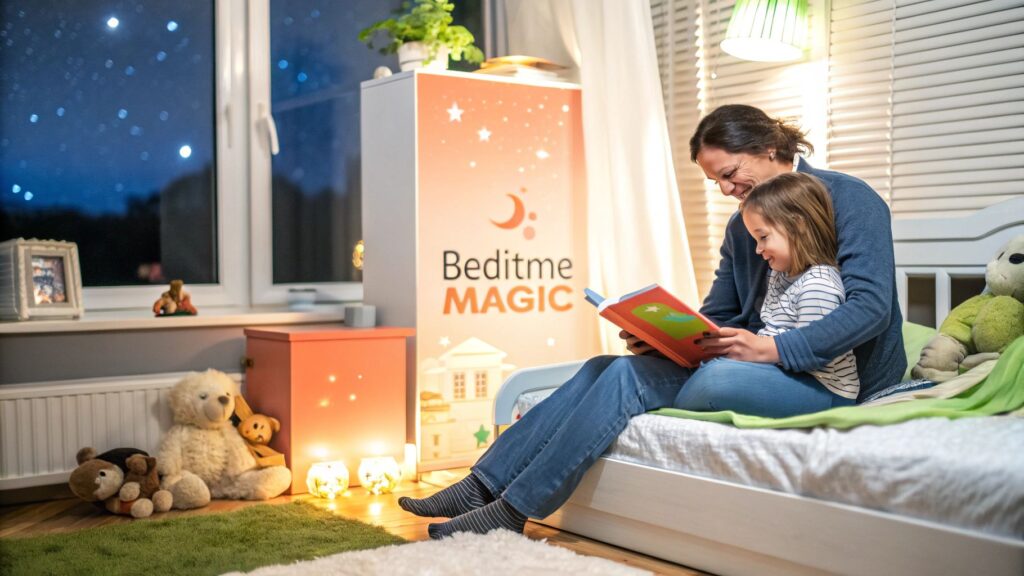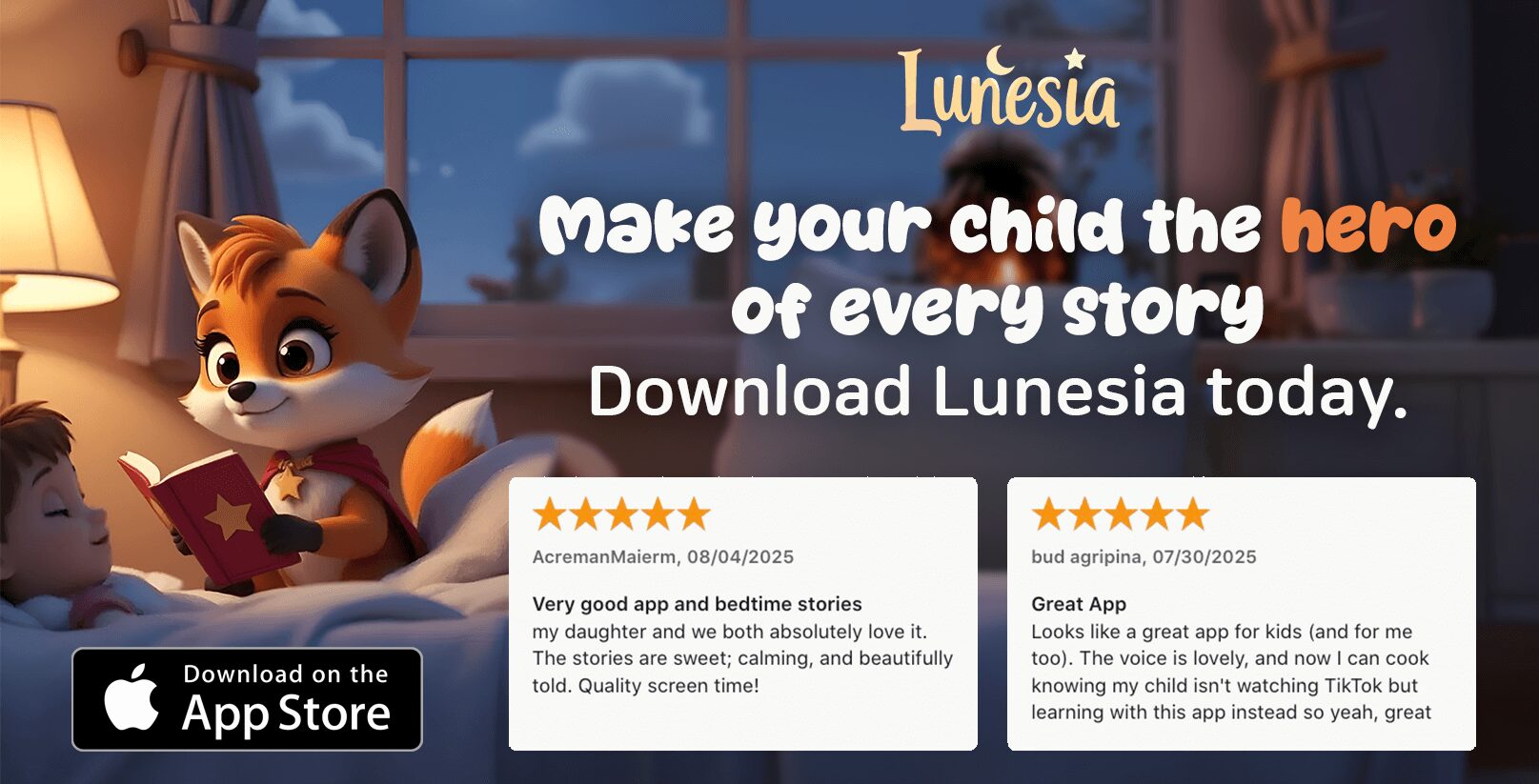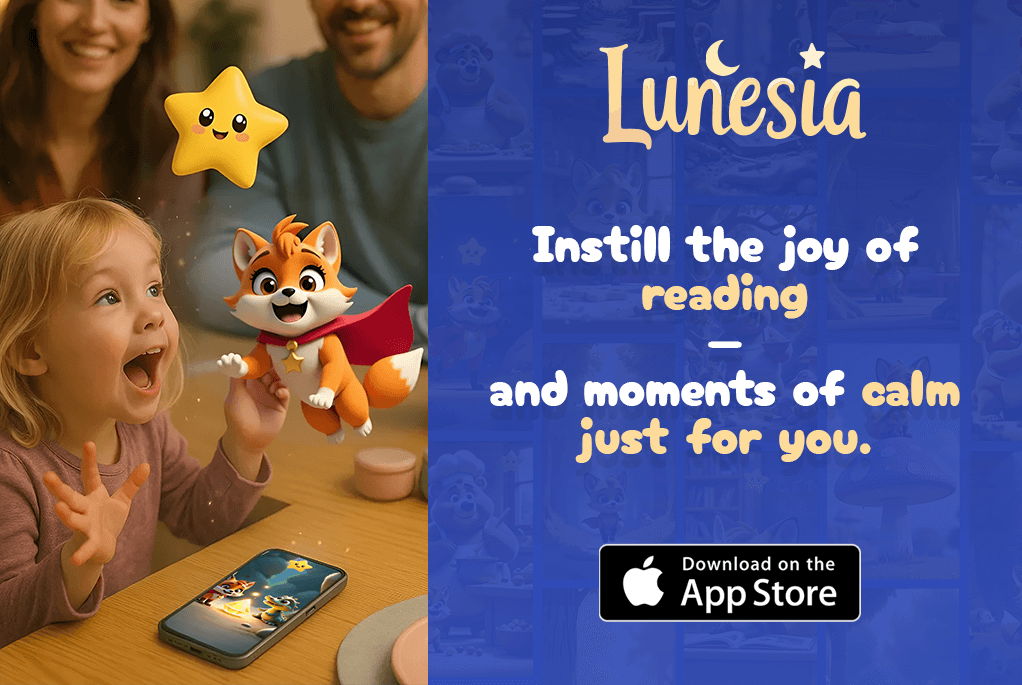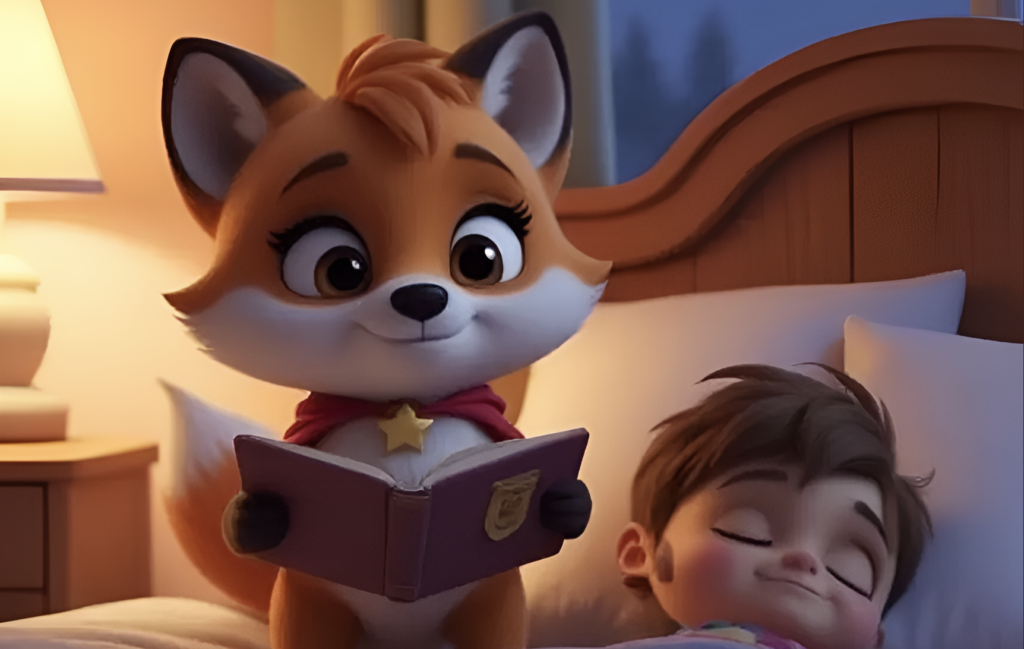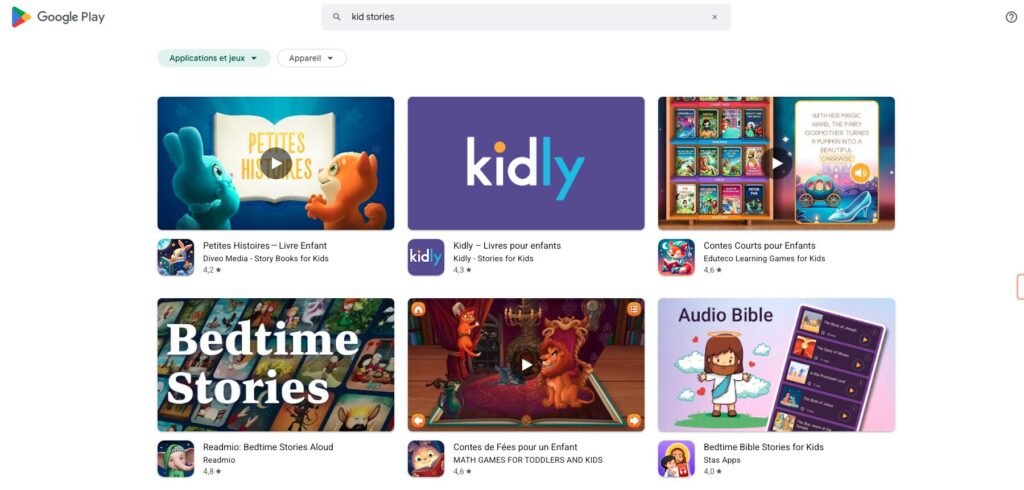Ever wonder if the story you choose tonight could shape how your child faces tomorrow? It’s not just about winding down. What if a simple 10-minute story could become your secret weapon for raising a resilient, emotionally intelligent child? A good bedtime story for kids is more than a sweet ending to the day; it's a powerful tool that builds connection, courage, and calm.
This isn't just another list of books. We’re diving into timeless classics and innovative interactive tales that do more than lull your child to sleep—they help soothe anxieties, spark imagination, and teach crucial values like kindness and problem-solving. Ready to transform your nightly routine from a chore into a cherished sanctuary? To further enhance the tranquility of your child's space, where these precious stories unfold, consider investing time in creating a serene and well-organized children's bedroom.
We'll explore not just what stories to read, but how they can help your child navigate big feelings and develop a lifelong love of reading. Let's find the perfect tale to build a brave, empathetic, and imaginative mind.
1. For Ultimate Calm: 'Goodnight Moon'
Ever feel like bedtime is a battle against boundless, chaotic energy? You’ve done the bath, the brushing, the pajamas… but your child is still buzzing. What if you had a story that didn’t just entertain, but actively calmed their nervous system? Enter Goodnight Moon by Margaret Wise Brown, a classic that has been the gold standard for peaceful bedtimes for over 75 years. This isn't just a book; it's a guided meditation for toddlers.

The story follows a young bunny methodically saying goodnight to every object in his "great green room," from the red balloon to the quiet old lady whispering 'hush.' Its magic lies in its hypnotic, repetitive rhythm. The illustrations by Clement Hurd also cleverly support this wind-down process. With each page turn, the room in the book literally gets darker, mirroring the transition from a bright, active day to the quiet of nighttime.
This predictable structure provides a powerful sense of security, signaling to a child's brain that the day is officially over and it is safe to rest. In fact, routines like this can reduce cortisol levels (the stress hormone) in children.
How to Use Goodnight Moon for Maximum Effect
Want to make this story work its full magic? It’s all about creating a ritual.
- Pace Your Reading: Read slowly and softly, matching the book's peaceful cadence. Your gentle voice is a key part of the calming process.
- Make it Interactive: Let your child point to the objects as you say goodnight. This simple act keeps them engaged while reinforcing the winding-down theme.
- Create a Bridge to Their World: After finishing, whisper "goodnight" to a few things in your child's own room. "Goodnight, teddy bear. Goodnight, window. Goodnight, little toes." This transitions the story's ritual into their immediate reality.
- Position it Last: To maximize its soothing power, make this the final story you read. It serves as the ultimate signal that sleep is the very next step.
By integrating Goodnight Moon into your routine, you’re not just reading one of the best bedtime stories for kids; you're teaching your child how to transition peacefully to sleep, a foundational skill for healthy emotional regulation.
2. For Exploring Big Feelings: 'Where the Wild Things Are'
Did a massive tantrum derail your afternoon? Is your child still wrestling with frustration as you try to tuck them in? When big, messy emotions like anger take over, you need a story that validates those feelings instead of shutting them down. Maurice Sendak’s masterpiece, Where the Wild Things Are, is the perfect tool for navigating emotional storms.

The story follows Max, a boy who, after making mischief, is sent to his room. His room transforms into a jungle, and he sails to an island of "Wild Things." He tames them and becomes their king, but eventually, he sails back home to find his supper waiting for him, "and it was still hot."
This imaginative journey provides a safe outlet for a child’s anger, showing them it’s possible to feel furious, explore those emotions, and still return to the safety and unconditional love of home.
How to Use Where the Wild Things Are for Maximum Effect
The key to this book is using it as a launchpad for conversation.
- Talk About the "Why": Before the wild rumpus starts, ask, "Why do you think Max is so angry?" This helps your child connect actions with feelings.
- Embrace the Rumpus (Safely): When the wild rumpus starts, encourage a little physical release. Let your child stomp their feet or make a quiet "roar" with you. It’s a playful way to acknowledge the physical side of big emotions.
- Highlight the Return Home: Emphasize the ending. Point out that even after he was angry, Max’s dinner was waiting. This powerfully reinforces that your love is constant, no matter how big their feelings get.
- Assess the Mood: This story can be stimulating. If your child seems too energized, follow it with a calmer story to transition them gently toward sleep. You can discover more about its enduring appeal and why it remains one of the most famous bedtime stories.
Instead of just reading about Max's journey, imagine if your child could make choices that helped a character manage their big feelings? That's the power of an app like Lunesia, where interactive stories let kids practice empathy and problem-solving, turning storytime into a safe training ground for emotional resilience.
3. For Interactive Learning: 'The Very Hungry Caterpillar'
Do you want a bedtime story that does more than just soothe? For nights when your child's mind is still buzzing with curiosity, you need a book that channels that energy into gentle, educational fun. Eric Carle’s The Very Hungry Caterpillar is a masterpiece of interactive storytelling, brilliantly disguising lessons about counting and nature within a charming, colorful narrative.

The story follows the journey of a caterpillar eating his way through the days of the week, culminating in his beautiful transformation. Its genius lies in its physical design, with die-cut holes that kids can poke their fingers through. It’s no wonder it has sold over 50 million copies; it makes learning feel like a game.
This hands-on engagement provides a satisfying, tactile experience that reinforces concepts like numbers and the days of the week, turning passive listening into active discovery.
How to Use The Very Hungry Caterpillar for Maximum Effect
To get the most out of this classic, lean into its built-in interactive elements.
- Make it Physical: Encourage your child to poke their fingers through the holes as the caterpillar eats. This connects them physically to the narrative.
- Count Aloud Together: As the caterpillar munches through one apple, two pears, and three plums, count each item out loud. This makes number recognition a natural part of the story.
- Discuss the 'Tummy Ache': Use the part where the caterpillar overeats as a gentle moment to talk about healthy foods. Ask, "Which foods made the caterpillar feel good?"
- Connect to the Natural World: The story provides the perfect introduction to the life cycle of a butterfly. Talk about the change from a tiny egg to a beautiful butterfly, sparking curiosity about nature.
By making The Very Hungry Caterpillar a multisensory experience, you’re not just reading one of the best bedtime stories for kids; you’re building a foundation for a lifelong love of learning, all wrapped up in a cozy bedtime routine.
4. For Unconditional Love: 'Guess How Much I Love You'
Are you looking for a story that ends the day with a powerful, emotional connection? On those days when you’ve felt more like a referee than a parent, Guess How Much I Love You by Sam McBratney is the perfect reset button. This tender classic beautifully captures the immeasurable bond between a parent and child.

The story is a sweet "competition" between Little Nutbrown Hare and Big Nutbrown Hare as they try to quantify their love. From stretching their arms wide to hopping as high as they can, each gesture grows bigger until Big Nutbrown Hare delivers the ultimate loving statement: "I love you right up to the moon… and back."
This book provides the perfect script for expressing love, giving children a tangible and understandable way to grasp the abstract concept of deep affection and emotional security.
How to Use Guess How Much I Love You for Maximum Effect
The real power of this book comes alive when you make it a shared experience.
- Act it Out Together: Don't just read the words; perform the actions. When Little Nutbrown Hare stretches his arms wide, encourage your child to do the same.
- Create a Bridge to Their World: After reading, ask your child, "How much do you love me?" Let them come up with their own creative answers. This transforms the story into a personal conversation.
- End with Your Own Loving Message: Conclude the ritual by whispering your own heartfelt "I love you" message. Tell them you love them more than all the stars in the sky. This makes the feeling of unconditional love the very last thing they experience before drifting off.
- Explore Love Through Interaction: Stories that allow children to explore emotions are incredibly powerful. For more ways to build on this, discover how interactive bedtime stories can help your child understand and express feelings like love and kindness in an engaging format.
By making Guess How Much I Love You a part of your routine, you’re not just reading a book. You’re building a foundation of emotional security and creating a cherished memory that reinforces the most important message of all: they are deeply and unconditionally loved.
5. For Reassurance and Security: 'The Runaway Bunny'
Do you ever see a flicker of separation anxiety in your child’s eyes as the lights go down? For a little one grappling with big feelings about being apart, bedtime can feel unsettling. This is where The Runaway Bunny, another masterpiece by Margaret Wise Brown, works its gentle magic. It's more than a story; it's a powerful emotional anchor.
The book unfolds a conversation between a little bunny who wants to run away and his steadfast mother. No matter where he imagines going—from becoming a fish to a rock on a mountain—his mother lovingly promises to find him. Her creative responses build a fortress of security around the child’s heart.
This gentle back-and-forth isn't just a game; it's a profound promise of parental presence, teaching children that love is a constant, no matter where their anxieties may lead them.
How to Use The Runaway Bunny for Maximum Effect
To transform this book from a simple story into a deep bonding experience, focus on the emotional connection it fosters.
- Emphasize the Mother's Tone: Read the mother bunny's lines with extra warmth and gentle certainty. Your voice becomes the sound of unconditional love.
- Pause for Connection: After the mother bunny says, "If you become a rock on the mountain, I will be a mountain climber and I will climb to you," pause and give your child a hug. Link the story’s reassurance directly to your physical affection.
- Discuss Their Safe Spaces: After reading, ask questions like, "What makes you feel safe and cozy?" This helps them connect the book's themes to their own feelings of security with you.
- Use it During Transitions: This is one of the best bedtime stories for kids facing changes, like starting school or a parent traveling. It provides a stable, comforting narrative when their world feels a little shaky.
6. For a Lesson in Love and Acceptance: 'Corduroy'
Does your child ever worry about not being perfect? In a world that often seems to demand flawlessness, Corduroy by Don Freeman offers a comforting and powerful counter-narrative. It’s a heartwarming tale about a small department store bear who, despite a missing button, finds a loving home.
The story follows Corduroy on his nighttime quest to find his lost button, believing it’s why he hasn’t been chosen. Meanwhile, a little girl named Lisa sees him and wants him anyway, returning the next day to take him home. The resolution is profoundly touching: Lisa doesn't care about the missing button and lovingly sews a new one on herself.
Corduroy masterfully teaches that true connection isn’t about perfection; it's about seeing the value in someone and offering them unconditional love and a sense of belonging.
How to Use Corduroy for Maximum Effect
To bring this story’s message of empathy and acceptance to life, you can extend its themes into your bedtime conversation.
- Connect to Their Comfort Objects: After reading, talk about your child's own favorite stuffed animal. Ask, "What makes Teddy so special to you?" This helps them articulate feelings of love beyond physical appearance.
- Discuss What Makes People Special: Use Corduroy's journey as a starting point to talk about friendship. You can ask, "Lisa loved Corduroy even with his missing button. What do you love about your friends?" This shifts the focus from external qualities to internal ones.
- Empathize with Being Different: Gently explore the feeling of being imperfect. You might say, "Corduroy was worried about his button. Do you ever worry about things like that?" This creates a safe space to discuss insecurities.
- Make it the Heart of the Routine: Read this story when your child needs a little extra reassurance. Its warm, comforting message about being loved unconditionally makes it a perfect story to end the day on a secure and happy note.
7. To Soothe Separation Anxiety: 'The Kissing Hand'
Is your child facing a new beginning like starting school, or do they dread the moment you leave their room at night? Separation anxiety is a powerful emotion. What if you had a tool that offered more than just a distraction? Audrey Penn's The Kissing Hand is a profoundly comforting story that gives children a tangible way to feel connected to you, even when you're apart.
The book tells the story of Chester Raccoon, who is nervous about leaving his mom for his first day of school. His mother shares a beautiful secret: she kisses the palm of his hand, telling him that whenever he feels lonely, he can press his hand to his cheek and feel the warmth of her love.
The "kissing hand" becomes a physical anchor for a child's emotions, providing a powerful, portable tool for self-soothing during times of stress or separation.
How to Use The Kissing Hand for Maximum Effect
This story's true power is unlocked when you bring its central ritual into your family's life.
- Make it a Physical Ritual: As you read, pause when the mother raccoon gives Chester the kiss. Gently take your child's hand and place a kiss right in their palm, just like in the book. Let them feel it and then press it to their own cheek.
- Use it Proactively: Don't wait for a moment of anxiety. Introduce this ritual during calm moments, making it a regular part of your bedtime routine before any big transition.
- Encourage Reciprocity: Ask your child to give you a kissing hand, too. This empowers them, showing that they can also provide comfort and love.
- Bridge to Their Feelings: When they express fear or loneliness, gently remind them about their special tool. Say, "Remember you have my kiss right there in your hand. Press it to your cheek and feel how much I love you."
Incorporating The Kissing Hand helps you do more than just read one of the best bedtime stories for kids; it provides a lasting strategy for managing anxiety. For more ideas on using stories to ease nighttime fears, explore these other calming bedtime stories on Lunesia.app.
7 Best Kids Bedtime Stories Comparison
| Title | Implementation Complexity 🔄 | Resource Requirements ⚡ | Expected Outcomes 📊 | Ideal Use Cases 💡 | Key Advantages ⭐ |
|---|---|---|---|---|---|
| Goodnight Moon | Simple, repetitive text and illustrations | Low: short length, basic illustrations | Calming, establishes bedtime routine | Bedtime for very young children (0-5 years) | Extremely calming, established classic |
| Where the Wild Things Are | Moderate: rich illustrations, complex themes | Moderate: longer story, detailed illustrations | Emotional processing, imagination stimulation | Teaching emotions, older preschoolers (3-8) | Encourages creativity, emotional depth |
| The Very Hungry Caterpillar | Simple interactive elements | Moderate: die-cut pages, colorful artwork | Educational engagement, concept teaching | Learning numbers, days, and nature (1-6 yrs) | Interactive, educational, engaging |
| Guess How Much I Love You | Simple dialogue with physical gestures | Low: soft illustrations, interactive actions | Reinforces emotional bonds, affectionate moments | Parent-child bonding, 2-7 years | Strengthens connection, interactive |
| The Runaway Bunny | Simple poetic language with rhythmic text | Low: basic illustrations with color highlights | Comfort and security, separation anxiety relief | Children with anxiety, 2-6 years | Deeply comforting, reinforces security |
| Corduroy | Moderate: narrative with warm illustrations | Low-Moderate: traditional illustration style | Acceptance, self-worth, gentle adventure | Addressing belonging and acceptance (3-7 yrs) | Teaches acceptance and empathy |
| The Kissing Hand | Simple narrative with physical action | Low: gentle illustrations | Separation anxiety relief, practical coping | Starting school, new experiences (3-8 years) | Practical coping strategy, reassuring |
Your Story, Your Connection: Turning Bedtime into a Lasting Legacy
The lights are low, the day is done, and in these quiet moments, you're doing far more than reading words from a page. You're building a fortress of love and security that will guide your child for years to come. The ritual of sharing good bedtime stories for kids isn’t just about sleep; it’s a powerful act of connection that shapes their understanding of the world.
We've journeyed through timeless classics that have soothed generations by teaching fundamental lessons about love, fear, and returning to safety. These stories are a beautiful thread connecting you not only to your child but also to your own childhood, reminding us that the core needs for reassurance and unconditional love are universal.
Beyond the Page: Building Skills for Tomorrow
But what if your child didn’t just hear about Max taming the Wild Things, but got to make brave choices themselves? This is where modern storytelling evolves. Apps like Lunesia offer a profound upgrade to the bedtime routine. Their interactive stories transform your child from a passive listener into an active protagonist. They aren't just hearing about kindness; they are choosing to be kind to a lost creature in a digital forest, and seeing the positive outcome of that choice.
This shift is a game-changer for emotional development. When children make decisions that shape the narrative, they learn that their choices matter. They practice empathy, problem-solving, and courage in a safe environment. Meanwhile, you get a moment of peace, guilt-free, knowing they are engaged in a meaningful, ad-free experience that’s building real-world skills.
Your Action Plan for a Better Bedtime
So, what’s your next step tonight? The "perfect" story is the one that fosters connection.
- For Familiar Comfort: Revisit a classic. Use a soft voice for The Runaway Bunny to reinforce the theme of unwavering parental love.
- For Tackling Big Feelings: If your child had a tough day, an interactive story on Lunesia where they help a character overcome a similar challenge can empower them to manage their own emotions.
- For Fostering a Love of Reading: Make storytime an event. Let your child pick the book. To continue fostering a love for reading and connection, you can also explore other books in the children's category to find new adventures to share.
Ultimately, whether you choose a cherished classic or an innovative interactive tale, you are giving your child an incredible gift. You are creating a treasury of memories they will hold onto forever. These moments are your legacy, woven from stories, whispers, and the simple, profound act of being present.
Ready to transform bedtime into a powerful adventure in learning and growth? Discover the world of Lunesia, where your child becomes the hero of their own story, building confidence and emotional intelligence with every choice they make. Download Lunesia today and unlock a library of interactive tales that make bedtime the best part of the day.
